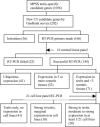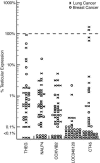Identification of cancer/testis-antigen genes by massively parallel signature sequencing
- PMID: 15905330
- PMCID: PMC1142383
- DOI: 10.1073/pnas.0502583102
Identification of cancer/testis-antigen genes by massively parallel signature sequencing
Abstract
Massively parallel signature sequencing (MPSS) generates millions of short sequence tags corresponding to transcripts from a single RNA preparation. Most MPSS tags can be unambiguously assigned to genes, thereby generating a comprehensive expression profile of the tissue of origin. From the comparison of MPSS data from 32 normal human tissues, we identified 1,056 genes that are predominantly expressed in the testis. Further evaluation by using MPSS tags from cancer cell lines and EST data from a wide variety of tumors identified 202 of these genes as candidates for encoding cancer/testis (CT) antigens. Of these genes, the expression in normal tissues was assessed by RT-PCR in a subset of 166 intron-containing genes, and those with confirmed testis-predominant expression were further evaluated for their expression in 21 cancer cell lines. Thus, 20 CT or CT-like genes were identified, with several exhibiting expression in five or more of the cancer cell lines examined. One of these genes is a member of a CT gene family that we designated as CT45. The CT45 family comprises six highly similar (>98% cDNA identity) genes that are clustered in tandem within a 125-kb region on Xq26.3. CT45 was found to be frequently expressed in both cancer cell lines and lung cancer specimens. Thus, MPSS analysis has resulted in a significant extension of our knowledge of CT antigens, leading to the discovery of a distinctive X-linked CT-antigen gene family.
Figures




References
-
- Brenner, S., Johnson, M., Bridgham, J., Golda, G., Lloyd, D. H., Johnson, D., Luo, S., McCurdy, S., Foy, M., Ewan, M., et al. (2000) Nat. Biotechnol. 18, 630–634. - PubMed
-
- Scanlan, M. J., Gure, A. O., Jungbluth, A. A., Old, L. J. & Chen, Y. T. (2002) Immunol. Rev. 188, 22–32. - PubMed
-
- Scanlan, M. J., Simpson, A. J. & Old, L. J. (2004) Cancer Immun. 4, 1. - PubMed
Publication types
MeSH terms
Substances
Associated data
- Actions
- Actions
- Actions
- Actions
- Actions
- Actions
LinkOut - more resources
Full Text Sources
Other Literature Sources
Molecular Biology Databases
Research Materials

